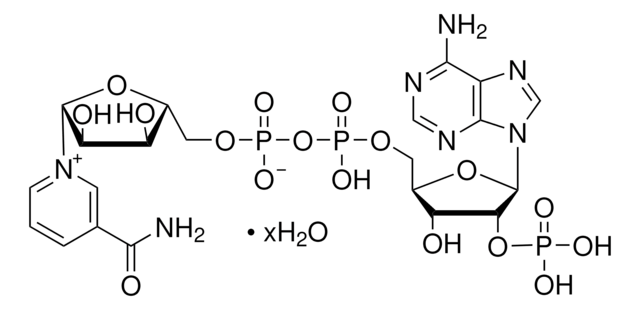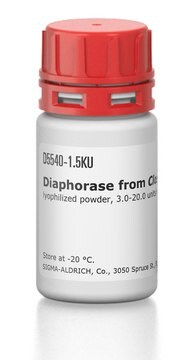G7509
GABase from Pseudomonas fluorescens
lyophilized powder, Protein ≥30 % by biuret
Synonyme(s) :
GABase Enzyme, GABase from Pseudomonas, Pseudomonas GABase
Se connecterpour consulter vos tarifs contractuels et ceux de votre entreprise/organisme
About This Item
Produits recommandés
Source biologique
Pseudomonas fluorescens
Niveau de qualité
Essai
≥30 % (biuret)
Forme
lyophilized powder
Activité spécifique
≥0.5 units/mg protein
Composition
Protein, ≥30% biuret
Technique(s)
inhibition assay: suitable
Température de stockage
−20°C
Description générale
Research area: Neuroscience
GABase is a commercially available mixture composed of γ-aminobutyric acid aminotransferase (GABGT) and succinic semialdehyde dehydrogenase (SSDH) obtained from Pseudomonas fluorescens.
GABase is a commercially available mixture composed of γ-aminobutyric acid aminotransferase (GABGT) and succinic semialdehyde dehydrogenase (SSDH) obtained from Pseudomonas fluorescens.
Application
GABase from Pseudomonas fluorescens has been used for GABase assay to quantify the extracellular and intracellular concentration of GABA (γ-aminobutyric acid).
Actions biochimiques/physiologiques
GABase catalyzes the conversion of γ-aminobutyric acid (GABA) to succinic acid in the central nervous system. It is used to measure GABA levels in various biological samples. p-Hydroxybenzaldehyde (HBA) is known to be a potential inhibitor on GABase.
Définition de l'unité
One unit will convert 1.0 μmole of γ-aminobutyric acid (GABA) to succinic semialdehyde and then to succinate per min with a stoichiometric reduction of 1.0 μmole of NADP+ at pH 8.6 at 25 °C.
Forme physique
Partially purified lyophilized powder containing buffer salts and stabilizer
Code de la classe de stockage
11 - Combustible Solids
Classe de danger pour l'eau (WGK)
WGK 3
Point d'éclair (°F)
Not applicable
Point d'éclair (°C)
Not applicable
Équipement de protection individuelle
Eyeshields, Gloves, type N95 (US)
Faites votre choix parmi les versions les plus récentes :
Déjà en possession de ce produit ?
Retrouvez la documentation relative aux produits que vous avez récemment achetés dans la Bibliothèque de documents.
Les clients ont également consulté
Kimon-Andreas G Karatzas et al.
Applied and environmental microbiology, 76(11), 3529-3537 (2010-04-20)
It is well established that the glutamate decarboxylase (GAD) system is central to the survival of Listeria monocytogenes at low pH, both in acidic foods and within the mammalian stomach. The accepted model proposes that under acidic conditions extracellular glutamate
A Vidal-Cros et al.
The Biochemical journal, 229(3), 675-678 (1985-08-01)
L-threo-3-Fluoroglutamate and L-erythro-3-fluoroglutamate were tested with glutamate decarboxylase from Escherichia coli. Both isomers were substrates: the threo isomer was decarboxylated into optically active 4-amino-3-fluorobutyrate, whereas the erythro isomer lost the fluorine atom during the reaction, yielding succinic semialdehyde after hydrolysis
Mingu Gordon Park et al.
Journal of enzyme inhibition and medicinal chemistry, 36(1), 2016-2024 (2021-09-14)
Many studies have focussed on modulating the activity of γ-aminobutyric acid transaminase (GABA-T), a GABA-catabolizing enzyme, for treating neurological diseases, such as epilepsy and drug addiction. Nevertheless, human GABA-T synthesis and purification have not been established. Thus, biochemical and drug
Hexigeduleng Bao et al.
Plant, cell & environment, 38(3), 600-613 (2014-07-31)
γ-Aminobutyric acid (GABA) accumulates in many plant species in response to environmental stress. However, the physiological function of GABA or its metabolic pathway (GABA shunt) in plants remains largely unclear. Here, the genes, including glutamate decarboxylases (SlGADs), GABA transaminases (SlGABA-Ts) and
Alejandra Hurtado-Romero et al.
Foods (Basel, Switzerland), 10(10) (2021-10-24)
Isolation and functional characterization of microorganisms are relevant steps for generating starter cultures with functional properties, and more recently, those related to improving mental health. Milk kefir grains have been recently investigated as a source of health-related strains. This study
Notre équipe de scientifiques dispose d'une expérience dans tous les secteurs de la recherche, notamment en sciences de la vie, science des matériaux, synthèse chimique, chromatographie, analyse et dans de nombreux autres domaines..
Contacter notre Service technique










